COMMENTS ON THE ART MARKET
Upcoming Show
The Nantucket Show
Our final show for the summer of 2024 takes place at Bartlett’s Farm on the island of Nantucket and runs from August 9 -12. Both Rehs Galleries and Rehs Contemporary will be participating. If you would like to attend, we do have some complimentary General Admission tickets.
____________________
Stocks & Crypto
Oh well, so much for that summer heat. Historically, July has seen some solid returns, but that was not quite the case this time around… in fact, the S&P had its worst July in a decade! Granted, it still turned in a 1.1% gain on the month, but the median return for July throughout the last ten years was closer to 3%. Frankly, I’m not sure that means too much – it’s not like history accurately predicts what’s to come… then again, we often characterize August as a month with muted gains and September as a loser. Anyway, the Dow turned in a solid return of 4.4% on the month, while the NASDAQ actually dipped 0.8%. The trend being noticed is investors are shifting away from Big Tech stocks into value stocks and small-caps… a trend being termed “The Great Rotation.” With the understanding that some investors felt they missed the AI boom, they looked to other undervalued opportunities relative to the market. Over the past month, value and small-cap stocks have outperformed large-cap and growth equities by some of the widest margins in years. For example, the Russell 2000 index, which we usually do not discuss but tracks the US small-cap sector, was up more than 10% in July… easily pacing the major indexes. All of this did not spell good news for my new automated stock trading that follows Nancy Pelosi and Tommy Tuberville’s stock trading… I’m now down over 10%. What the heck, Nancy!! I thought you had all the inside info?!? Oh well.
Turning to currencies and commodities, the British Pound and Euro gained value relative to the US Dollar… up 1.6% and 1%, respectively. The other way of framing that is the US Dollar fell on weak economic data, particularly data that showed US manufacturing contracted while employment fell, raising alarms over a potential US recession – I thought we were past the whole recession concern, but I guess there’s always a chance. With that in mind, gold notched a 4.2% gain as investors seek to shield themselves from inflation and recession concerns… it now sits at an all-time high in the $2,500 ballpark. Crude futures fluctuated in the high 70s – low 80s… it ultimately settled around $78 at the end of July, which was a 4.6% slide through the month.
It was a mixed month in the crypto arena… Bitcoin was the odd man out as it notched a small gain of 4.2%. Ethereum slid 6.7%, while Litecoin gave up 6.4%... these kinds of numbers feel rather insignificant when we’re talking about assets as volatile as cryptocurrency.
As I alluded to earlier, August is historically an even month as the markets prepare for the “September Effect,” the bizarre occurrence of regular losses in Septembers… hopefully, with July bucking the trend of strong gains, the next few months will be different than the norm. That is unlikely but wishful thinking… hold on tight; things may get weird.
____________________
Introducing: Alik Bures

From a young age, Alik was enchanted by the world of art, a passion he attributes to his father, a talented product designer known for his remarkable sketching skills. This early fascination led him to explore a wide range of mediums, including sketching, painting, and even creating replica pieces of his favorite video game characters. His adventurous spirit extended to making his own tattoo guns and testing them on himself, demonstrating his relentless pursuit of artistic expression. After a stint in college football, he discovered the captivating world of glass in 2016. Drawn to the rich heritage of Borosilicate glass and inspired by the innovative pipe makers community, he overcame the "taboo" associated with cannabis and collegiate athletics to pursue his passion. Over the next five years, he evolved from designing functional pipes to focusing on non-functional sculpture work, which he terms "Effusions." These freestyle sculptures reflect his emotions through aggressive angles and vibrant styles. His work is a testament to his belief that art is not just a form of expression but a way of life.

____________________
Really!?
Justin Timberlake Mugshot Gets Warhol Treatment

Justin Timberlake
(photo courtesy of Georges Biard)
In the early morning hours of June 18th, police in Sag Harbor, New York, pulled over and arrested pop star Justin Timberlake for driving while intoxicated. He had refused to take a breathalyzer and failed the field sobriety test. Shortly after, Sag Harbor police released his mugshot, showing Timberlake’s bloodshot, glazed-over eyes. While many felt shocked or disappointed over the news, a pair of artists recognized the arrest as a memorable moment in popular culture. They, therefore, decided to give the mugshot the Warhol treatment.
Painter Robert Lohman and photographer Mary Godfrey decided to use the Timberlake mugshot as the basis for a series of inkjet prints in four different color variations. The neon greens, blues, and pinks used in the series provide brightness against the photo’s context, a celebrity’s moment of shame. The prints resemble Andy Warhol’s colorful portraits of the twentieth century’s most iconic figures, including Marilyn Monroe, Muhammad Ali, and Queen Elizabeth II. According to Lohman, this was done rather intentionally: “Andy Warhol’s genius was in knowing which images would capture and evoke a moment in time, and Justin’s mug shot seemed to me to do exactly that. I thought it was deserving of the Warhol treatment, and I believe Andy would approve.” Lohman and Godfrey are selling the series, called Tuesday Night Out Featuring Justin Timberlake, through the Romany Kramoris Gallery in Sag Harbor. Funnily enough, the gallery is directly across the street from the American Hotel, where Timberlake allegedly had only one Martini before getting in his car. The Kramoris Gallery is currently selling the prints for $520 each. In the short time they’ve been available, the Timberlake series has already received a fair bit of attention, with calls coming in from across North America, even as far as Germany and Australia.
There are, however, some questions about the prints’ legality. While mugshots are typically in the public domain, New York State has a law on the books protecting what is called the “right of publicity.” New York State law prohibits you from using someone’s likeness for a commercial purpose unless you obtain a license. However, should such an issue arise in the courts, the artists and the gallery can claim that the series has enough artistic merit and is sufficiently transformative to claim fair use of the image. These potential legal issues raise concerns about the boundaries of artistic expression and the rights of public figures. However, these questions will go unanswered unless Timberlake files a lawsuit.
Original Harry Potter Illustration Makes Magic
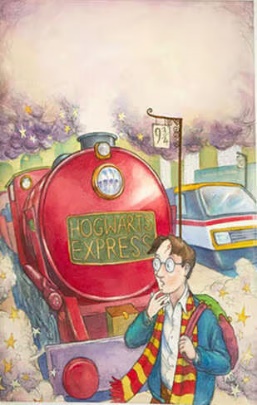
Illustration
Children’s book author and illustrator Thomas Taylor, at the age of 23, created the original cover art for J.K. Rowling’s Harry Potter and the Philosopher’s Stone, as noted by Sotheby’s catalogue description. This iconic illustration for the first edition of the 1997 novel recently sold for an astonishing sum, while Taylor was only paid a mere $650 when he did the commission.
Initially estimated to fetch up to $600K, the highest presale value ever placed on a Harry Potter-related item, the final bid was a thrilling surprise. After nearly 10 minutes of spirited four-way bidding, the artwork sold for more than three times the anticipated amount, leaving everyone in the room in awe of the unexpected turn of events.
The cover art features the character Harry Potter, easily recognizable by his dark hair, round glasses, and lightning bolt scar. He stands poised to board the Hogwarts Express for his first journey to Hogwarts School of Witchcraft and Wizardry. The artwork was used for various translated editions except for the U.S. version, Harry Potter and the Sorcerer’s Stone. This captivating watercolor illustration captured several collectors’ attention. It is signed and dated (‘Thomas Taylor 1997’) on the back and captioned and signed on the accompanying cover sheet. The piece shows faint color variations and tape remnants at the edges, which do not affect the image, adding to its character and history. The work previously auctioned in London in 2001, and sold for £85,750, about four times its then estimated price.
The prior record for a Harry Potter-related item was held by an unsigned first edition of Harry Potter and the Philosopher’s Stone, which sold for $421,000 in 2021. At the time of the book’s release, Taylor worked in a bookshop, where his colleagues proudly informed customers that their local bookseller had illustrated the popular novel. In a dramatic conclusion, the illustration with an estimate of $400-600K, ultimately sold for a record-breaking $1.6M ($1.9M w/p).
Napoleon’s Pistols Hit The Mark

Courtesy of Michel Bury/Osenat
Napoleon Bonaparte, one of history’s most renowned military leaders, rose to prominence during the French Revolution and became Emperor of France. His ambitious campaigns and strategic prowess expanded the French Empire across much of Europe. However, his invasion of Russia in 1812 marked the beginning of his downfall. Despite initial successes, the harsh Russian winter and scorched-earth tactics devastated his army. Napoleon’s eventual defeat led to his abdication and exile, first to Elba and later to Saint Helena, where he died in 1821.
In April 1814, following a series of battles against a coalition of European states formed in response to his Russian campaign, Napoleon faced defeat. Despite winning several battles, Paris fell to the allied coalition on March 31, 1814. In the days following this loss, Napoleon’s mental state deteriorated, and he considered suicide. His friend and squire, Armand de Caulaincourt, recalled that Napoleon “had been talking about how to kill himself for days” and frequently examined his pistols, removing bullets from his nécessaire. Eventually, after signing the Treaty of Fontainebleau, Napoleon attempted to kill himself using poison. He survived the attempt, abdicated, and was exiled to Elba, an island off the Italian coast.
Recently, two flintlock Gossard pistols once owned by Napoleon were sold at auction; they were the ones he had given to Caulaincourt after his suicide attempt. The pistols were displayed in a Burr walnut box with ebony inlay. Both the box and the guns bear Napoleon’s cipher.
Just a week before the pistols were to be auctioned, the French government declared them a national treasure, meaning that they could not leave France. That did not deter the bidding war that ensued. The guns were initially valued at an estimated €1.2M-€1.5M ($1.3M-$1.63M) and finally hammered down at €1.35M ($1.47M) (€1.69M—$1.83M w/p).
Yuan Dynasty Fish Jar Swims Far Beyond The Estimate

Chinese blue and white fish jar
in the Yuan style,
courtesy of Aste di Antiquariato Boetto
The atmosphere at Aste di Antiquariato Boetto in Genoa was electric when a 12-inch (30 cm) blue-and-white Chinese vase, initially valued at €2,000-2,300, was sold for more than 400 times the low estimate. The unexpected sale of this rare Yuan dynasty fish jar or guan from the 1350s sparked a fierce bidding war, leaving the auction house and bidders in awe.
The jar’s distinctive ‘fish-in-waterpond’ motif, characteristic of Yuan dynasty ceramics, attracted quite a bit of interest, to say the least. The design, featuring four types of fish —qingyu (mullet), baiyu, liyu (carp), and guiyu (mandarin fish)— is rich in Daoist symbolism, representing spiritual freedom, a valued concept among China’s intellectuals.
Collectors have preserved numerous Yuan fish jars of varying quality and price. The finest examples can command extraordinary sums; one from the Joseph Hotung collection fetched nearly HK$40 million (or just over $5 million) at Sotheby’s Hong Kong in October 2022.
These large jars were among the first blue-and-white porcelain pieces and were often used to store alcohol or water for tea. Archaeological finds suggest they were produced at several notable ceramic centers, including Longquan, the Cizhou kilns, and Jingdezhen.
When the intense bidding war finally concluded, the new owner paid a staggering €820K ($881K), far surpassing all expectations. This extraordinary sale in Genoa not only underscores the lasting allure and substantial value of Yuan dynasty ceramics but also highlights their profound historical and artistic significance.
____________________
The Dark Side
Barberini Bribery
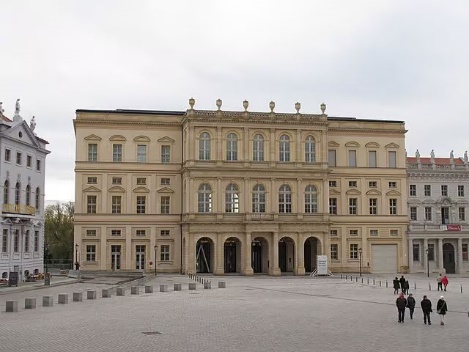
The Museum Barberini
(photo courtesy of Daniel Naber)
The Museum Barberini is one of the newer museums in the Berlin area. It opened in 2017 in Potsdam, immediately southwest of Berlin, to display the collection of Hasso Plattner, co-founder of the German software company SAP SE and one of the wealthiest individuals in the country. The permanent collection mostly consists of Impressionist and Post-Impressionist paintings, while the rotating exhibitions feature loans ranging from the Old Masters to contemporary art. And now the Museum Barberini may be caught up in a small bribery scandal.
The Barberini is one of two museums Plattner has founded in the greater Berlin area, the other being Das Minsk, dedicated to modern and contemporary art with an emphasis on East German artists. It is named after the Barberini Palace, the eighteenth-century neoclassical structure that houses the museum. An Allied air raid destroyed much of the palace in 1945, with the property going unused until 2013. A local redevelopment project saw it completely rebuilt, with Plattner footing the bill. The museum opened in 2017, but the bribery incident occurred during construction. A German court found that a civil engineer serving as part of the management team for the museum’s construction asked for money in exchange for giving rival construction companies insider information about the project. This information, which included transcripts of meetings among the managerial team, resulted in the company that agreed to pay the bribes winning the contract. The firm promised him €80K, of which they paid €29K before terminating the payments due to the investigation. There was also another incident where the engineer helped a friend of his earn money from the project as a subcontractor. Emails between the two reveal that the engineer advised his friend to be at the construction site at least twice a week to establish credibility.
The court has sentenced the engineer to fourteen months in prison and a €113K fine. This is in addition to paying €20K to a local children’s charity. The subcontractor received a suspended sentence and was ordered by the court to pay €180 per day for one hundred twenty days, adding up to €21.6K. Fortunately, the museum’s construction was not used with public money, otherwise the scandal would have had far greater consequences.
Russian Museum Charged For Nazi Messages

The Erarta Museum, St. Petersburg
(photo courtesy of Erarta)
The Erarta Museum in St. Petersburg, a significant repository of Russia’s modern and contemporary art, is now at the center of a controversy. This esteemed institution, housing several thousand pieces from the 1950s to the present, is being accused of displaying works that contain Nazi slogans.
A case has recently been brought against the museum regarding a painting by the Belarusian artist Sergei Grinevich called Festival. The work consists of a group of dancers in traditional Belarusian folk costumes while a trio of menacing security guards in black suits stand in front. The painting has been in the Erarta permanent collection since 2016. However, the charges against the museum pertain mainly to the slogan spray-painted underneath the painting in 2020, which has remained since then. Around that time, someone wrote Zyvie Bielarus! or Long Live Belarus! on the wall beneath the painting. While it seems rather innocuous, the phrase has certain political connotations. Much like how the phrase Slava Ukraini, literally Glory to Ukraine, has been taken up by Ukrainian resistance to Russia’s invasion of and ongoing war in Ukraine, Zyvie Bielarus has been used by certain political elements in Belarus. These political elements are typically those of the opposition to President Alexander Lukashenko, dubbed Europe’s last dictator. 2020, when the slogan first appeared, was a turbulent time in Belarus. Lukashenko’s reelection was highly contested, surrounded by allegations of fraud which provoked widespread demonstrations, the largest the country has seen since Lukashenko first gained the presidency in 1994. Freedom of speech and the press in Belarus is some of the worst in Europe. He has also been a close ally of Russia under Vladimir Putin, leading to censorship of anti-Lukashenko rhetoric in Russia. It, therefore, seems that the administrative charges against the museum are likely a legal means to shut down any criticism of Lukashenko. In the past, the artist has criticized Belarusian authorities of censorship, which only reinforces this interpretation. The painting itself can also be interpreted as a criticism of strongmen like Putin and Lukashenko, who use folk imagery combined with nationalism to strengthen their rule.
However, the prosecutors are using a law prohibiting Nazi symbols and messages as a pretext. The charges against the museum claim that the phrase Zyvie Bielarus was used by several Eastern European fascist collaborationist groups who worked with the Nazis during the Second World War, namely the 13th Police Battalion and the 30th Grenadier Division, both of which worked under the SS. Given Russia’s strict stance on anything related to the Nazis, the museum may have to surrender the painting and pay a hefty fine of 50,000 rubles (about $580). This could have serious implications for the museum and the artist.
Picasso Drawing Included In 1MDB Forfeitures

1MDB Logo
The 1MDB scandal is one of the largest instances of corruption in history, and its fallout has been in the news for almost a decade. Now, the United States Department of Justice has confiscated a Picasso drawing used to conceal stolen money.
The 1Malaysia Development Berhad (1MDB) was a sovereign wealth fund that the Malaysian government used to attract foreign investment starting in 2009. In their mandatory audit of the company, Malaysia’s Auditor-General submitted a report detailing their findings. However, the country’s National Security Council classified the report under the Official Secrets Act. A 2015 document leak exposed how Prime Minister Najib Razak, who made 1MDB into a state entity, funneled roughly $700 million from the company into personal bank accounts. When Razak’s party lost the 2018 general election, the new government subsequently declassified the audit, exposing how 1MDB was used to misappropriate billions of dollars. The scandal prompted investigations in Malaysia, the United States, Britain, Switzerland, Australia, and others. The FBI estimates stolen money adds up to $4.5 billion, while Swiss authorities say the number might be as high as $7 billion. One of the ways those involved hid the embezzled money was by using it to buy real estate and other assets, including art. Najib was eventually tried and convicted of money laundering, abuse of power, and breach of trust. The court sentenced him to 12 years in prison in 2020. Meanwhile, the alleged mastermind of the money laundering scheme, Jho Low, escaped Malaysia and has been living as a fugitive, most likely in China.
With art used to hide stolen money, authorities have confiscated art since the investigations began, with Van Goghs and Basquiats forfeited in the process. Low has recently agreed to forfeit roughly $100 million in assets to the Department of Justice. These assets include an apartment in Paris as well as several paintings, including one by Claude Monet and another by Andy Warhol collectively worth about $35 million. In this most recent development, though, the Justice Department has confiscated a Picasso drawing, Trois femmes nues et buste d’homme, from 1MDB’s former general counsel Jasmine Loo Ai Swan. The drawing, created in 1969, is worth approximately $1.27 million. Loo was able to purchase the drawing through Christie’s in 2014 using embezzled money. Along with the Picasso, Loo also forfeited a Swiss bank account totaling approximately $500K. This is just one small part of the $1.4 billion the United States has helped return to Malaysia in the scandal’s wake. Despite these forfeitures, Low and Loo are not exempt from any criminal charges they face in Malaysia, the United States, and courts in other countries. Low currently faces federal charges in New York that include money laundering and trying to bribe government officials in Malaysia and the United Arab Emirates. He also faces charges in a Washington DC court trying to conceal campaign contributions during the 2012 election.
____________________
The Art Market
Christie’s Old Masters
This week, many of the main London auction houses will be hosting a variety of sales focusing on the art of the old Masters. Christie’s kicked everything off on Tuesday, July 2nd, with a duo of auctions. The morning sale focusing on prints did fairly well, but it was the later evening sale that drew everyone’s attention. Of the twenty-four lots available, much of the art world press focused on what eventually became the star of the sale: The Rest on the Flight into Egypt by Titian.
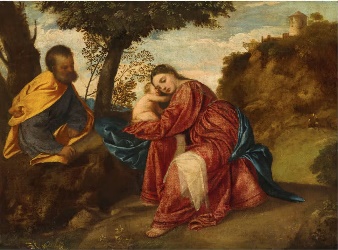
The Rest on the
Flight into Egypt by Titian
The painting is one of the artist’s first great works, created sometime around 1512 when he was likely still studying in the studios of Gentile and Giovanni Bellini. It shows a biblical scene popular among European artists, where Mary and Joseph take the newborn Jesus and flee to Egypt to escape the Massacre of the Innocents ordered by King Herod. Showing the Holy Family in a moment of brief rest during the flight into Egypt became popular during the Renaissance, with artists like Caravaggio, Rembrandt, and Van Dyck all tackling the subject. Rest on the Flight into Egypt has an impressive provenance, including European nobility and royalty. It has also been stolen on two occasions, first from the Belvedere Palace in Vienna during the Napoleonic Wars. The second theft occurred in 1995 when thieves took the painting from Longleat House in Wiltshire. Longleat is an estate owned by the Thynne family, who hold the title Marquess of Bath. Seven years after the theft, a former Scotland Yard officer finally recovered the Titian, receiving a tip and locating the painting in a plastic bag at a bus stop in London. The sale at Christie’s on Tuesday marked the first time the painting appeared at auction since the Thynne family first purchased it in 1878. Andrew Fletcher, Christie’s global head of Old Masters, called it “the most important work by Titian to come to the auction market in more than a generation”. Christie’s assigned it an estimate of £15 million and £25 million. However, despite its impressive provenance and the media attention, the Titian received few bids, just enough to get it to its minimum estimate of £15 million / $19 million (or £17.56 million / $22.26 million w/p). This set a new auction record for a Titian painting, which was previously set at Sotheby’s in 2011 when the painting A Sacra Conversazione sold for $16.88 million w/p.

Madonna of the Cherries
by Studio of Quentin Metsys
Next was another religious painting, one of the three Madonna & Child paintings available on Tuesday. This one bears the title of Madonna of the Cherries from the studio of the Antwerp Renaissance painter Quentin Metsys. The Madonna of the Cherries was a popular subject during the Renaissance, with the original version first created by Leonardo da Vinci. A version of the subject by Metsys’s contemporary Joos van Cleve sold for £80K hammer in April 2022 during a Sotheby’s Old Masters online sale. The Metsys studio rendition offered at Christie’s on Tuesday last sold in 2015 for £254.5K w/p. However, in the nine years since its last appearance at auction, some restoration work has been done. Not only are the painting’s colors brighter, but the restoration also revealed that a later artist painted a sheer green drape over the window in the background. With that gone, the trees, clouds, and birds in flight that the curtain once obscured are now visible. With Christie’s specialists assigning it an estimate of between £8 million and £12 million, the Madonna of the Cherries eventually hammered at £9 million / $11.4 million (or £10.66 million / $13.5 million w/p), with the Getty Museum in Los Angeles reported as the buyer. Like the Titian, this was another auction record for the artist, with the previous record held by a painting sold in 2020 for $1.9 million w/p. However, with such a high estimate and a final price, it seems interesting that the Madonna of the Cherries is attributed to the artist’s studio rather than the artist himself. It may indicate that the Getty Museum or any future owner may bump up the attribution to just the artist, omitting the studio altogether to justify the large sum of money paid.
And finally, moving away from the religious works, the sale’s third place was a portrait by one of the best of the Old Masters in that genre, Frans Hals. Portrait of a Gentleman of the de Wolff Family is a half-length portrait of an older man with a ruff and a large-brimmed hat. The portrait’s subject is unknown, with several theories circulating among our historians for over a century. The coat of arms in the upper right-hand corner certainly helps, as it shows wolves’ heads against a red background. This has led some to deduce that he was a member of the de Wolff family, possibly the cloth merchant Joost de Wolff. The Hals portrait hammered within its £4 million to £7 million, selling for £4.7 million / $5.9 million (or £5.7 million / $7.2 million w/p).

Portrait of a Gentleman
of the de Wolff
Family by Frans Hals
Surprises are rare in sales like this since they feature a relatively small number of higher-value lots. However, a couple of lots managed to sell far above their initial estimates Christie’s gave them. First, there was Sir Peter Lely’s Portrait of Barbara Villiers. The subject was a prominent noblewoman in seventeenth-century England. She held the titles Countess of Castlemaine and Duchess of Cleveland, later appointed as Queen Catherine’s Lady of the Bedchamber, and was even one of King Charles II’s mistresses. Expected by Christie’s specialists to sell for no more than £180K, the Lely portrait hammered at £450K, or two-and-a-half times its high estimate. Then, there was Pieter Coecke van Aelst’s 1530 painting Saint Jerome in His Study. While depictions of Saint Jerome often show him as an ascetic living in the wilderness, Van Aelst’s Saint Jerome is a scholar and the compiler of the Vulgate Bible. Van Aelst retains the inclusion of a skull in the painting, a popular component of Saint Jerome’s iconography as a symbol of mortality, but otherwise decorates the saint’s study with a cardinal’s hat, candles, books, a clock, and other items. Christie’s expected the painting to sell for a maximum of £200K, yet it eventually sold for £540K / $684.6K (or £680.4K / $862.6K w/p).
Despite the success of most of the high-value lots, Christie’s could have done better. Seven of the twenty-four lots available on Tuesday sold within their estimates, giving Christie’s a 29% accuracy rate. Only four lots (17%) failed to sell, leaving the auction with an 83% sell-through rate. Seven lots (29%) sold below estimate, while six (25%) sold above. However, among the four that went unsold was George Stubbs’s Mares and Foals in an Extensive Landscape. It is one of the most prominent paintings from the artist’s series of works on the subject, measuring nearly six by nine feet. Christie’s, therefore, assigned it a hefty estimate range of £7 million to £10 million. While the Stubbs received a few bids, interest ran out at £6.5 million. With the Stubbs failing to sell, the auction could not make its presale estimate minimum of £41.4 million. The twenty-four lots offered at Christie’s brought in £36.4 million / $46.2 million.
Sotheby’s NY Modern Discoveries Online Sale
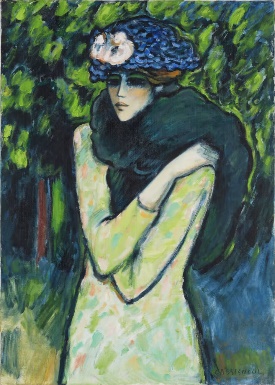
Le renard bleu
by Jean-Pierre Cassigneul
On Wednesday, July 17th, Sotheby’s New York hosted an online sale called Modern Discoveries. While online sales are common at major auction houses, it is easy to dismiss them as places where many lower-value pieces get sold. Some see them as an opportunity to sell items that cannot fit into the more prominent sales with actual, living people at the podium. However, Modern Discoveries showed that there are often hidden gems tucked away in these auctions. The sale lasted nearly three hours on Wednesday afternoon, offering one hundred forty-one lots. These consisted mostly of works by European and North American artists like Milton Avery, Maximilien Luce, and Françoise Gilot. The sale’s top lots reflect this makeup. The first one came early on with Jean-Pierre Cassigneul’s Le renard bleu, a 1976 Post-Impressionist-inspired portrait of a woman. The painting has been in the same collection since the artist sold it through Findlay Galleries in Chicago. As well as being the top lot of the sale, the Cassigneul was also one of the sale’s big surprises. Estimated by Sotheby to sell between $40K and $60K, the portrait shot past its estimate range, with the timer running out after the final bid of $140K (or $168K w/p). The Cassigneul seemed to have set an example, as all the top lots at Sotheby’s that day were pieces that exponentially exceeded their high estimates.
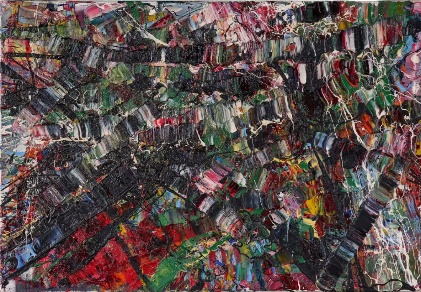
Pays by Jean-Paul Riopelle
Though created more than twenty years earlier than the Cassigneul, the second-place lot seems more modern and avant-garde. The 1954 painting Pays by the Canadian artist Jean-Paul Riopelle is one of the “mosaic” paintings that initially made a name for the artist. He created these by using a palette knife instead of a brush, spreading a mixture of paints across the canvas and seeing how it comes out. Riopelle first exhibited his mosaic paintings in Paris in 1953, the year before this work’s creation. This series contributed to the artist’s increasing popularity in Europe, which also led to a more passionate rivalry between the respective abstract art scenes in New York and Paris. Like the Cassigneul, the Riopelle also sold far beyond its estimate range. With Sotheby’s specialists assigning a $40K high estimate, the mosaic painting sold for three times that much at $120K (or $144K w/p).

For Sale by Andrew Wyeth
Finally, two works shared the third place spot: For Sale by Andrew Wyeth is a 1951 watercolor-and-pencil on paper showing what seems to be an abandoned barn likely in Maine. The other was a nineteenth-century painting by the American artist J.G. Brown called St. Patrick’s Day. Brown is renowned among his contemporaries for his attention to detail. In the painting, we see a young shoeshine boy, as indicated by the box on his back. A young girl pins a green ribbon to his coat while he carries a small green flag with a harp and the phrase Erin Go Brach. This is an adaptation of the Irish Gaelic phrase Éirinn go Brách, or “Ireland until the end of time.” The painting is not only an intimate domestic scene between children, presumably siblings, but it shows the significance of the Irish and Irish-American communities in the United States. Though Irish immigration to North America peaked in the 1840s and 1850s, it was still going strong well into the nineteenth century. By the time Brown painted St. Patrick’s Day in 1877, symbols of Irish nationality and Irish pride were more accepted than in decades past. National pride among Irish immigrants and their descendants became incredibly important for the cause of Irish independence from Britain well into the next century. Brown’s paintings have not been particularly popular since the 1990s, with only a few exceptions in recent years. This includes the painting A Thrilling Moment, sold at Christie’s in January 2023 for $650K (or $819K w/p). St. Patrick’s Day is by far the most expensive Brown painting sold since then. Both the Brown and the Wyeth hammered at $110K (or $132K w/p) against respective estimate ranges of $20K to $30K and $60K to $80K.
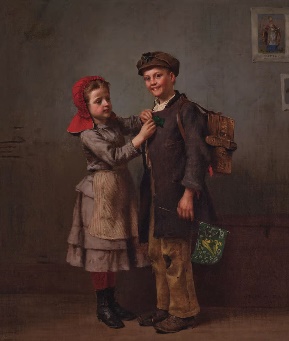
St. Patrick’s Day by J.G. Brown
The items originally expected to lead the sale included Milton Avery’s painting Artist at the Sea (est. $100K to $150K), Marc Chagall’s pastel Les Fiancés à la chèvre (est. $60K to $80K), and an Andrew Wyeth drawing entitled Archies Corner (est. $60K to $80K). These lots in particular either sold underestimate or were bought in. Other highly-valued lots had mixed results. Had the best performing lots only reached their high estimates, the sale would have failed to bring in the sum initially predicted by the specialists. Though most of the top lots were unexpected surprises themselves, the biggest surprise at Sotheby’s that day came in the middle of the sale. Modern Discoveries featured four works by the fashion designer and heiress Gloria Vanderbilt. While the four had mixed results, few expected the oil painting Women on the Beach to achieve more than its $7K high estimate. It ended up selling for over seven times that amount at $50K (or $60K w/p). It stands out among Vanderbilt’s other work, which normally features a more vibrant color palette.
Of the one hundred forty-one lots available at Sotheby’s on Wednesday, thirty-eight sold within their estimates, giving the specialists a 27% accuracy rate. Unfortunately, many more lots sold below their estimates, adding up to fifty lots (35%). Another twenty-three lots (16%) sold above, while thirty lots (21%) went unsold. Against a total minimum presale estimate of $2.08 million, Sotheby’s Modern Discoveries just managed to sneak by with $2.15 million (or $2.6 million w/p). Even though many lots fell short of expectation, the fact that they sold at all was likely another factor that salvaged the sale in the end.
____________________
Deeper Thoughts
Valenciennes Museum Proposes Name Change
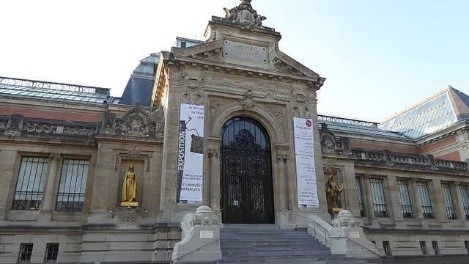
The Musée des Beaux-Arts,
Valenciennes (photo courtesy of Pierre André)
The Musée des Beaux-Arts in Valenciennes, with its rich history and diverse collection, stands as a testament to the cultural evolution of northern France. In addition to housing one of the country’s most important collections of Flemish paintings, it also contains a wide variety of art across many genres and media. This diversity has led the museum administration to consider changing the museum’s name.
Museum leadership says its current name is “too limiting” and has announced it will change it as part of its ongoing renovations. The nineteenth-century building’s glass roof panels are in need of repair, but the renovations and the name change are parts of a larger Scientific & Cultural Project. This project, mandated by the national Ministry of Culture, aims to amplify the Valenciennes museum’s role as “a crossroads museum”, “a living museum”, and “a plural museum”. The museum being a crossroads is easy enough to understand. Valenciennes, close to the border with Belgium, is where cultures clash and synthesize both daily and over centuries. French, Habsburg, and Burgundian authorities have all ruled over the city, leaving their respective marks on local culture. Accepting the museum’s and the city’s identity as a crossroads is to recognize its “multifaceted identity, the fruit of a turbulent and multicultural history.” Becoming a living museum, on the other hand, pertains more towards looking at the future as well as the past. It indicates the desire to approach art as both a collection of static objects and a living process that continues today. They seek to embrace “the liveliness of art in the making” by welcoming contemporary artists into museum spaces. And then, finally, there is the creation of a plural museum. This is what the proposed name change seeks to address. The Scientific & Cultural Project recognizes that the museum’s collection is more than simply fine art. The Valenciennes Musée des Beaux-Art is renowned not just for painting and sculpture but for its archaeology and antiquities collections, as well as examples of the area’s heritage of craftsmanship. This includes the city’s lace and porcelain products, coveted throughout Europe through the eighteenth and nineteenth centuries. Exhibiting antiquities and crafts, particularly those from the surrounding area, aims to help locals “reconnect with this prestigious past that is barely visible today” due to conflict and a shifting geopolitical landscape.
Some French cultural commentators like Didier Rykner are pushing back against the name change and the entire Scientific & Cultural Project altogether, decrying it as “wokeism”. In reality, the term ‘wokeism’ is just as indefinable and amorphous as ‘fine arts’, now only serving as a final resort for critics who have few legitimate reasons for their criticism. Rykner criticized the name change as merely a semantic issue, quoting the French politician Jean Jaurès: “When men cannot change things, they change words.” But it seems Rykner has not paid any attention to what the Scientific & Cultural Project entails. The Valenciennes museum’s name change would not be aspirational; quite the opposite, actually. It is to reflect a change that has already occurred. Such criticisms, therefore, ring hollow, exposing that there are few things to complain about.
Even if critics like Rykner have nothing to stand on, keeping the museum’s current name may be good. While it is true that the ‘fine arts’ have typically only included certain media like painting, sculpture, and prints, there are two sides to this coin. The museum has decided that it is not restricted just to the fine arts and will, therefore, change its name to reflect the collection’s contents. However, there is another route: don’t change the name to meet the definition, but change the definition to reflect the name. The latter option would completely redefine fine art among cultural institutions. Oxford Languages defines fine art as “visual art whose products are to be appreciated primarily or solely for their imaginative, aesthetic, or intellectual content.” This definition implies that objects with a practical purpose do not qualify as fine art. A piece of porcelain can be beautiful and appreciated in a museum setting for its aesthetic value and craftsmanship. Still, it may have originally been intended for kitchen and dining use. The same thing goes for a necklace or a ring. The metalworking can be beautiful by itself but was intended to be worn on one’s finger or about one’s neck. Is it the name of the museum that is restricting, or is it our definition of fine art? What is and is not fine art is incredibly subjective, with our definitions changing from generation to generation. An artist’s intent is important for some, while their training and talent may be more important for others. The museum has not even chosen a new name yet, but I would be fine with a cultural institution like the Valenciennes Musée des Beaux-Arts changing its name if it feels like it does not reflect its collection or purpose. However, doing something as revolutionary as daring to change the definition of fine art would be exciting, indeed.
Rouen Cathedral On Fire
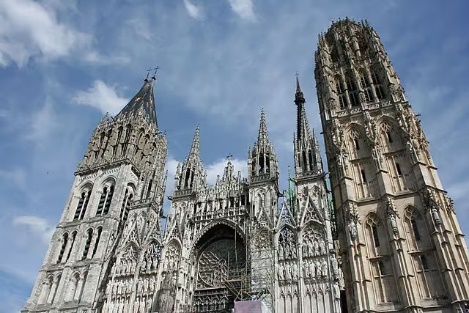
Rouen Cathedral
(photo courtesy of Deborah Cordwell)
In the late morning of Thursday, July 11th, a fire broke out in Rouen Cathedral in northern France.
The cathedral is one of the most famous in the country. Though first consecrated in the eleventh century, in the presence of the Duke of Normandy William the Conqueror, the structure was built and rebuilt over many centuries, exhibiting several styles of architecture, including Gothic, Flamboyant, Renaissance, and even nineteenth-century Gothic Revival. After the spire was reconstructed in the nineteenth century, for a few years Rouen Cathedral was the tallest building in the world. However, many criticized the architect Jean-Antoine Alavoine’s design of a cast iron spire, with the writer Gustave Flaubert calling it “the dream of a metalworker in a delirium”. The cathedral is a significant part of art history not only for its architectural significance but also as the subject of some of Claude Monet’s most famous paintings. Between 1876 and 1880, Monet executed a series of paintings showing the church at different times of day, in different weather and light. Parts of this series are now on display in museums worldwide, including the Musée d’Orsay in Paris, the National Gallery of Art in Washington DC, the Getty Museum in Los Angeles, and the Musée des Beaux-Arts in Rouen itself.
It is currently unknown how the fire started, but it initially broke out in the spire, where construction and renovation works are ongoing. Security footage shows smoke beginning to waft from the construction area at around 11:05 am. Emergency services evacuated the building and managed to prevent the fire from spreading to the rest of the church. Many people, particularly across France, may have recalled the unpleasant memories of the 2019 Notre Dame fire. One eyewitness interviewed by local television confirmed this: “The first thing we thought was what happened in Paris, it was a shock of course.” Fortunately, the Rouen fire was nowhere near as extensive as the one at Notre Dame; damage was minimal. The spire is made primarily out of cast iron, which kept the fire contained. It seems like the cast iron design so widely lambasted during its construction kept the cathedral from meeting a fate similar to Notre Dame. It was mainly the scaffolding and white construction tarp around the spire that were damaged. With the reconstruction of Notre Dame wrapping up in time for the 2024 Olympic Games in Paris, it would have been devastating to some if yet another example of French architecture were damaged or destroyed.
The Barbizon School: Tree-Huggers & Trailblazers
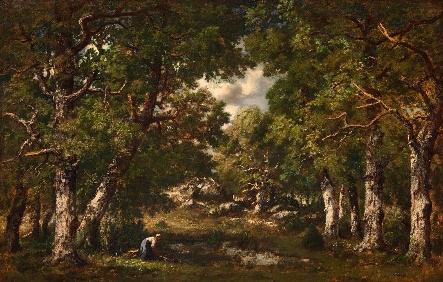
Femme ramassant du bois près d’une are en forêt
by Narcisse Virgilio Díaz de la Peña
In my series on the origins of modern art, I’ve looked at the predecessors that influenced the birth of Impressionism. The topics I’ve covered include the desire for greater artistic independence as exhibited by Gustave Courbet, the ways Jean-Auguste-Dominique Ingres experimented with abstraction, and how J.M.W. Turner helped elevate landscape painting to a genre worthy of respect and admiration. On that last note, Turner was incredibly influential on Impressionist painters like Monet and Pissarro. But on top of Turner’s landscapes, the Impressionists were also greatly inspired by the landscape painters of their own country, known as the Barbizon School. This earlier generation of French landscape painters pioneered painting en plein air, one of the key components of Impressionist painting. This is the Barbizon School, the environmentalist painters who paved the way for modern European art.
Until the Barbizon School, landscapes were a very different genre of painting. The art historian Steven Adams refers to pre-Barbizon landscapes as employing a “stage-managed approach”. For several centuries, landscape paintings were often not truthful depictions of nature. Rather, they were settings for biblical and historical subjects. Painters like Poussin and Lorrain popularized the genres of classical or historical landscape, creating entirely fictional natural backdrops for gods, heroes, prophets, and warriors. The closest forebears to the Barbizon painters were the seventeenth-century Dutch landscape artists like Jacob van Ruisdael and Aelbert Cuyp, whose conventions had gone by the wayside until revitalized by British artists like J.M.W. Turner and John Constable. By the 1820s, the Salon had only recently begun accepting Romantic paintings on top of traditional academic and neoclassical art. They were not, however, willing to give credit to landscapes and similar art forms, as they were considered mere imitations of the natural world without any messages or ideas baked into them.
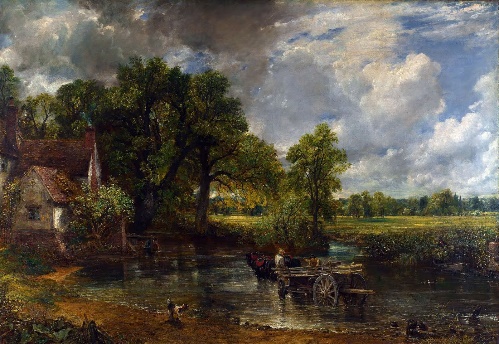
The Hay Wain by John Constable
The true story of the Barbizon painters starts earlier in the nineteenth century. First, in 1817, the Académie des Beaux-Art introduced a category in the Prix de Rome, one for paysage historique, or historical landscape. This led to renewed interest in landscape painting as a genre. Then, in 1824, the British landscape painter John Constable exhibited some of his work at the Paris Salon. Most famously, he showed his 1821 painting The Hay Wain, which King Charles X awarded a gold medal. Several other British artists exhibited at the Salon that year, including David Wilkie and Thomas Lawrence, with their work becoming far more popular in France than in their native country. Many young French artists at the time saw Constable’s paintings as almost revolutionary, pushing them out the studio door and into the open air. These young painters became driven to go out into nature, experience its sublime power, and distill it into a moment they could put to canvas.
Since most of these artists were based in Paris, there were few nearby places they could visit for inspiration; though there was one area they could go: the forest of Fontainebleau, just southeast of the French capital. On the forest’s border was a small village called Barbizon, where these young painters would stay. Some artists, like Jean-Baptiste Camille Corot, had already been experimenting with landscape painting before Constable’s work showed up at the Salon. However, with this final push, he and many of his contemporaries like Charles-François Daubigny, Constant Troyon, Narcisse Virgilio Díaz de la Peña, and Théodore Rousseau flocked to this village, mainly staying at an inn called the Auberge Ganne. Today, the inn is a museum, displaying its old registry filled with the names of many of France’s great nineteenth-century artists.
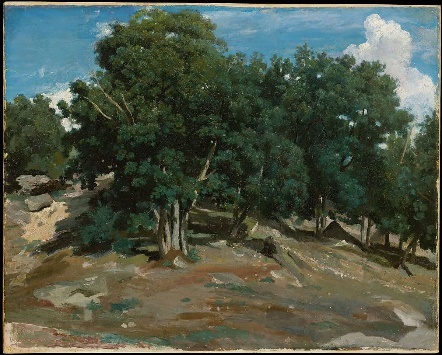
Fontainebleau: Oak Trees at Bas-Bréau
by Jean-Baptiste Camille Corot
At first, these young painters made their landscapes cautiously and conservatively, going out into the forest every day to make studies and sketches before creating a completed composition in a studio. But some painters later broke these conventions, trying to complete a painting in as few sessions as possible. To do this, they had to take their canvases and paints into the forest to paint outside, or en plein air. Completing an entire painting outside was a revolutionary new technique. The Barbizon artists used it to best capture the landscape as a whole rather than focus on its component parts. This practice also resulted in the Barbizon painters focusing less on finer details. For example, Corot caused a scandal after submitting the painting Fontainebleau: Oak Trees at Bas-Bréau to the Salon. The brushwork was loose, with whole sections having minimal detail. To the academic conservatives, it seemed hastily done. To the younger generation, meanwhile, it represented a new sense of spontaneity not yet seen in European fine arts. It was actually the works of painters like Corot, Daubigny, and some other Barbizon artists to which the term “impression” was first applied. It would be revived to criticize the next generation of artists, only this time the name stuck.
The Barbizon painters only started to gain wider acceptance around 1830. This is why, in the French-speaking world, these artists are not called Barbizon; rather, they are referred to as the School of 1830. This connects them to the political upheaval in France at the time, which saw the second and final overthrow of the Bourbon kings in favor of the liberal monarchy of King Louis-Philippe. With political change, the French public became more accepting of cultural and artistic change. This mirrors how the 1848 Revolution that overthrew Louis-Philippe is often connected to the birth of Realism pioneered by Gustave Courbet. Many artists saw the increasing popularity of landscape painting as connected to greater political liberalization and the push for democracy. The Salon that year and throughout the early 1830s included paintings inspired by the revolution, like Eugène Delacroix’s Liberty Leading the People, Philippe-Auguste Jeanron’s Les Petits Patriotes, and Hippolyte Lecomte’s Combat de la Porte Saint-Denis. This was when some of the early Barbizon paintings were exhibited as well.
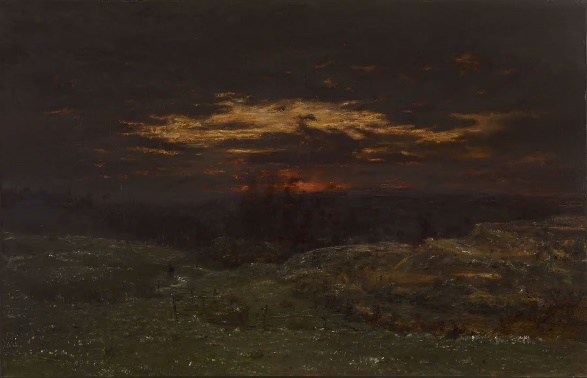
Hoar Frost by Théodore Rousseau
Originally, the painters would flock to Barbizon to stay for part of the year. But in the 1840s, artists like Rousseau and Millet would permanently move to the village. There, each of the painters went down their own path. Despite Rousseau’s initial Salon successes, the academy juries later rejected his work the more time he spent in Barbizon; between 1836 and 1841, all of his works submitted to the Salon were rejected. This led to the artist’s nickname, le Grand Refusé, or the Great Reject. At this point, he retreated into the forest, creating landscapes that focused on the subtleties of light at certain points in the day. His 1845 painting Hoar Frost is probably his best-known example of this practice. In doing so, Rousseau became a forerunner of the Impressionists, specifically Claude Monet, who would make several series of paintings focusing on the same subject under different weather and light conditions.
While Rousseau focused strictly on nature itself, other Barbizon painters would incorporate figures to populate their canvases. Constant Troyon and Jules Dupré often featured livestock and other animals, giving the scenes a pastoral feel while refraining from adding too many human elements. Such work would likely impact genres like animal painting, pioneered by Rosa Bonheur. Meanwhile, Jean-François Millet became influenced by Courbet’s Realism, incorporating scenes of French peasant life into his work. By doing so, Millet became particularly influential on the two main diverging branches of painting: Impressionism and Academicism. Of course, he became an example of a painter who goes out into the world and paints it as he sees it. With technological improvements like collapsible paint tubes, the Impressionists followed this example and went out into nature to capture a moment as quickly as possible. His unvarnished, Realist looks into the difficulties of rural life also served to show that great art did not have to focus on elevated subjects as the academic painters did. However, in his focus on scenes of French peasant life, Millet would actually come to influence later generations of academic painters like Jules Breton, Julien Dupré, and Jules-Alexis Muenier. These academics would apply traditional techniques to genre paintings. By looking at his most famous work, The Gleaners, one can see how his style and choice of subject impacted both Impressionist and academic painting.
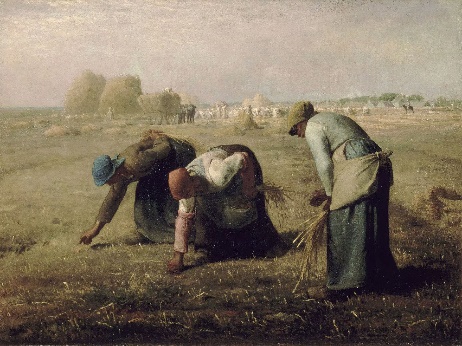
The Gleaners by Jean-François Millet
Although their influence on modern art is what they are primarily known for, the Barbizon painters’ activities also had another consequence. The forest of Fontainebleau was the Barbizon painters’ preferred subject. These painters formed a connection with the area’s landscape that most Parisians did not have. Because of their prolonged relationship with the area, many noticed the changes taking place there in the form of people cutting down old trees and planting new ones. These artists objected to any alteration to the landscape, forming the Association des Amis de la Forêt de Fontainebleau (AAFF) in 1839. Working in tandem with Claude-François Denecourt, the Barbizon painters and the AAFF managed to get over 6,000 square kilometers of forest protected as part of a nature sanctuary in 1853, designated off-limits to timber operations. Later, in 1861, an imperial decree issued by Napoleon III designated close to 11,000 square kilometers of the forest as a “réserve artistique”. Thanks to their efforts, Fontainebleau became the world’s first nature reserve, predating the foundation of Yellowstone National Park by eleven years.
By the 1860s, the Barbizon painters were now established artists when a new generation of painters emerged. Like their idols, these younger painters went to paint in the forest of Fontainebleau, staying at the Auberge Ganne and trodding some of the same ground as their predecessors. Artists like Monet, Renoir, and Sisley all got their start by trekking off and painting the forest, mastering the art of Barbizon painting before heading off in their own direction. They took Barbizon techniques further, developing them into Impressionism, kickstarting most forms of modern art in Europe. Without them, we would have no Van Gogh or Gauguin, nor would we have Picasso, Rothko, or Basquiat. They may seem like simple, quaint landscapes nowadays, but it’s important to remember how something so simple could result in something revolutionary.
Botero In Rome

Adamo and Eva by Fernando Botero,
on display in Medellín in 2006
Starting last week, some of Rome’s public squares will feature the work of the late, great Colombian painter and sculptor Fernando Botero.
The Botero a Roma exhibition features eight large sculptures on display in the public spaces of Rome’s historic center. The Fernando Botero Foundation is putting it on along with several Italian cultural organizations like Il Cigno Arte, Il Cigno GG Edizioni, and BAM Eventi d’arte. The exhibition includes Standing Man (Adamo) and Standing Woman (Eva) in the Piazza del Popolo, Horse with Bridle just off the Via del Corso, and Cat in front of the Basilica di San Lorenzo in Lucina. While his work is often remembered for its subjects’ exaggerated voluptuousness, there’s more to Botero than making things look fat. Botero explored the sensuality of their form by playing with the size and shape of people and animals.
Italy had special meaning for Botero, as he traveled there at age twenty following his first solo show in Bogotá. There, he studied the Italian Old Masters, combining their influence with the indigenous and colonial Spanish elements in his work. He would return to Italy in the 1970s, where he undertook new sculpture projects, which he exhibited at the Grand Palais in Paris in 1977. Though he lived mainly in Paris and Monte Carlo, Botero also had a house in the Tuscan town of Pietrasanta. The town has long been known as the region’s cultural and artistic hub, particularly for sculptors. The area’s marble quarries and those of nearby Carrara are considered some of the best in the world. Artists ranging from Michelangelo to Henry Moore have visited, worked in, and lived in Pietrasanta. One of the last sculptural shows for Botero’s work before the ongoing Rome exhibition was held in Pietrasanta to commemorate the artist’s eightieth birthday in 2012.
Other works are publicly viewable at the Terrazza del Pincio, the Largo dei Lombardi, the Piazza Mignanelli, and the Piazza San Silvestro. The artist’s daughter, Lina Botero, helped curate the exhibition. “From every point of view, Italy was his second homeland, not only for the admiration he had for its art but the love he felt for what he also considered his homeland.” Botero passed away last year at the age of 91, with his ashes buried in Pietrasanta. Therefore, the Botero a Roma exhibition seeks to continue his works’ “permanent celebration of life”. It does seem somewhat ironic, though. In a place so full of public monuments and sculptures, to draw attention with the addition of more public sculptures is an impressive feat. Botero’s monumental sculptures will be on display throughout Rome until October 1st.
Rembrandt Painting Exposes Colorful Secret
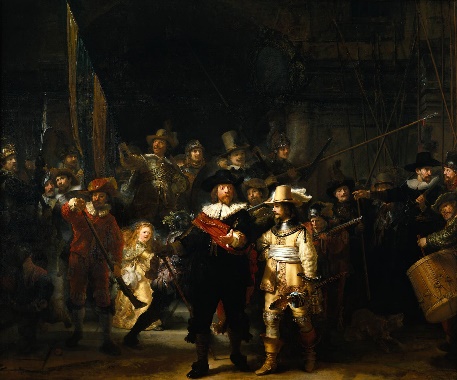
The Night Watch by Rembrandt van Rijn
Dutch scientists have made a fascinating discovery through meticulous tests on Rembrandt’s masterpiece The Night Watch. They have concluded that the artist likely had access to materials previously thought unavailable in seventeenth-century Amsterdam, a revelation that challenges our understanding of Rembrandt’s palette and techniques.
The Night Watch, one of Rembrandt van Rijn’s most iconic paintings, is undergoing a thorough restoration process. This enormous group portrait, created in 1642, was initially thought to depict a night scene, a misconception due to a layer of dark varnish that was not removed until the 1940s. The current restoration efforts, known as Operation Night Watch, began in 2019. In a novel approach, the Rijksmuseum in Amsterdam has transferred the painting into an enormous glass enclosure, ensuring that specialists can access the painting without removing it from public view. Operation Night Watch aims to fully document the restoration, mapping out the entire painting bit by bit to gain a comprehensive understanding of how Rembrandt created it. In this process, specialists have discovered where the paint has specifically discolored, the locations of the canvas’s deformations, and elements that are now missing from the present work. Most recently, however, chemists have found that Rembrandt used specific varieties of pigments previously thought unavailable to him.
Fréderique Broers and Nouchka de Keyser, PhD students at the Van ’t Hoff Institute for Molecular Sciences at the University of Amsterdam, worked alongside Rijksmuseum specialists in detecting the presence of sulfur and arsenic in some of the pigments. They were found specifically in the detailing for one of the painting’s main figures, Lieutenant Willem van Ruytenburch. After detecting arsenic in the paint, they initially concluded that Rembrandt likely used realgar and orpiment pigments for his red and orange-yellow paints. However, after further analysis, they found something more interesting. The actual pigments used were more unusual, as they contained pararealgar, which is a yellow pigment, and semi-amorphous pararealgar, which is more orange-red. Normally, that would not be interesting as realgar degrades into these compounds as it ages. But since the paint seems unaltered and both pigments are distributed rather evenly, the specialists concluded that Rembrandt had intentionally used pararealgar and semi-amorphous pararealgar to achieve the sort of shimmering gold effect found in the detailing of Van Ruytenburch’s coat. At the time, pigment manufacturers and vendors could synthetically create these pigments by treating naturally-occurring mineral realgar through sublimation. Because of this process and the fact that the materials were imported, these pigments were rare in seventeenth-century Dutch paintings. Researchers first picked up on the presence of these compounds in 2021, but they have finally published their complete findings in the journal Heritage Science. According to the report, “A comprehensive review of historical sources gives insight into the types of artificial arsenic sulfides that were available and suggests that a broader range of arsenic pigments could have been available in Amsterdam in the seventeenth century than previously thought.” The team also tested paintings by Rembrandt’s contemporaries to see if they could detect pararealgar. Eventually, they detected pararealgar in the Willem Kalf still-life painting Still Life with a Silver Jug and a Porcelain Bowl.
Arsenic sulfides have been previously found in several Rembrandt paintings, including The Jewish Bride. However, they have never been commonly associated with the artist’s palette. Their presence in The Night Watch shows these pigments’ intentional use and may lead to further studies into several subjects. These include the availability of certain colors to Dutch Golden Age artists, how these painters consciously used color, and the seventeenth-century world’s interconnectedness through commerce.
Royal Portrait Rediscovered Through Social Media

The Shire Hall portrait
of King Henry VIII
When we say a piece of art is lost, it doesn’t mean it’s intentionally hidden, buried somewhere for treasure hunters to find later. It just means we don’t know where it is right now. Often, lost pieces of art are not hidden but on full display. Sometimes, it just takes the right person to determine what it is. In the case of a lost royal portrait, it took someone online to do just that.
Adam Busiakiewicz is an art specialist who works as a consultant for Sotheby’s. He recently stumbled upon a post on Twitter/X from the official account of the Warwickshire Lieutenancy. The post was a simple image of a gathering at Shire Hall, the meeting place for the county council. Many paintings were on the walls in the background, but one in particular caught Busiakiewicz’s attention. It is a half-length portrait of King Henry VIII. After reaching out to the council and personally inspecting the work, Busiakiewicz confirmed that the painting is indeed a lost masterpiece commissioned by the tapestry maker Ralph Sheldon in the 1590s.
The Sheldon family is well-known among art scholars since they can trace over one hundred fifty surviving tapestries to their looms. The most famous of these are four large tapestry maps, each showing Warwickshire, Gloucestershire, Worcestershire, and Oxfordshire. Some Sheldon tapestries are now at major museums, including the Metropolitan Museum of Art and the Victoria & Albert Museum. The Henry VIII portrait is, in fact, one of twenty-two round-top portraits that the Sheldon family commissioned showing prominent figures. The family originally kept these portraits at their home in the village of Long Compton, Warwickshire, where they were incorporated into the dining room’s architectural details. However, the family sold the paintings at auction in 1781. The locations of many of these paintings are unknown, but some are now in prominent collections. For example, the portrait of Cardinal Thomas Wolsey is now at the National Portrait Gallery, while Eton College has both Kings Henry VI and Henry VII.
Even though there is evidence that the portrait now kept at Shire Hall is one of the Sheldon portraits, there are still some gaps in the provenance. The Sheldon portrait was last sold at auction in 1908 at Christie’s, while the Warwickshire county council bought the Shire Hall portrait in 1951. More rigorous testing is needed to confirm that the two paintings are the same. Appropriately, the council has handed the painting over to the Museum Collections Centre in Warwick. Although Busiakiewicz did not valuate the portrait, other works from the Sheldon collection have previously sold for up to £200K. According to Busiakiewicz, “In any case, the painting’s current attribution to ‘Style of Hans Holbein’ is probably overdue an update!” Should the Shire Hall portrait be confirmed as one of the lost Sheldon portraits, it would be an incredible coincidence. Close to two centuries after leaving the Sheldon home, it would be rediscovered just twenty miles north.
Mona Lisa Comment Causes A Stir

Mona Lisa by Leonardo da Vinci
Should the Mona Lisa be relocated to Italy? This question was raised after a prominent archaeologist answered in the affirmative.
Zahi Hawass is arguably the most famous archaeologist in the world. As an Egyptologist, he has taught at both Egyptian and American universities. He has also served as excavation and/or restoration director at many archaeological sites, including Giza, Saqqara, Abu Simbel, and the Valley of the Kings. Furthermore, he is also a vocal proponent of returning Egyptian antiquities to their country of origin. These include the Rosetta Stone in the British Museum, the bust of Nefertiti in Berlin’s Neues Museum, and the many obelisks taken from Egypt to serve as public monuments in Europe and elsewhere. Small details can often have widespread consequences when dealing with subjects such as this. And, of course, for many of these items, it’s on a case-by-case basis, which is why Hawass may have needed to think a little more carefully when he announced he would support efforts to return the Mona Lisa to Italy. He should have been careful because there’s just one problem: for something to be returned somewhere, it had to be there in the first place. And the Mona Lisa has never spent much time in Italy.
The Mona Lisa has only spent a few months outside France in the five centuries since its completion. Of course, scholars and the public often hail Leonardo da Vinci as one of the great figures of the Italian Renaissance. The Mona Lisa’s subject is also Italian, as Lisa del Giocondo was the wife of a prominent Florentine merchant. However, Da Vinci spent his final years in France as a guest of King Francis I. Da Vinci took the Mona Lisa with him, having worked on it on and off for over a decade. After he died in 1519, the portrait went to Leonardo’s friend and pupil Salaì, who then, in turn, sold it to King Francis. It remained in the French royal collection, moving from palace to palace, such as the Tuileries, Fontainebleau, and Versailles. After the French Revolution, the government moved the Mona Lisa to the Louvre, where it has remained ever since… for the most part.
For much of its history, the Mona Lisa was not a particularly well-known painting outside of scholarly circles. That changed in 1911 when the Italian nationalist Vincenzo Peruggia stole the painting from the Louvre and tried to sell it to the Uffizi Gallery in Florence. He believed that a masterpiece by a great Italian artist should be exhibited at a great Italian museum. The Uffizi’s director, however, had no intention of being an accomplice to the theft. The Uffizi exhibited the Mona Lisa for two weeks before returning it to Paris. Some say that more people visited the Louvre to look at the empty space on the wall than they ever did to see the painting itself. This incident cemented the painting’s international fame. The only other time the painting has left France is for special international exhibitions. The French government loaned the painting to the United States for exhibition in New York and Washington between December 1962 and March 1963. Later, France lent it for exhibition at Tokyo’s National Museum, followed by Moscow’s Pushkin Museum in 1974.
Although most art historians accept that the Mona Lisa has spent nearly all its time in France, Italian nationalists often put forward a different provenance. France has to be the story’s villain to give Italy any claim over the Mona Lisa. Therefore, some claim that King Francis stole or seized the painting illegitimately. Others will claim that Leonardo actually left the Mona Lisa in Italy rather than bring it to France. According to this alternate history, the painting stayed in Italy until Napoleon’s Italian campaigns in the 1790s, with French troops bringing the portrait to France. French troops brought many pieces of Italian art to France during the Napoleonic Wars, but the Mona Lisa was not one of them. Mistakenly grouping the portrait with these other artworks likely set Vincenzo Peruggia’s plan in motion. But in an era where information is so readily available, no one should be using this argument now. In an article for The Art Newspaper, art historian Martin Kemp wrote, “We may feel that the naïve Peruggia can scarcely be blamed for jumping to the wrong conclusion. Hawass has less excuse.”
Restitution has to be considered on a case-by-case basis. Every work of art in a museum far away from where it was first created has a different history and circumstances from each other. This only becomes more obvious with older items that are centuries old. Some of these paintings and antiques pre-date the formation of the countries that now ask for their return. Many artifacts have been taken from Egypt. Some were stolen, others were gifted or sold off by Ottoman authorities. If the Egyptian government asks for the return of the Luxor obelisk, now at the Place de la Concorde in Paris, can Turkey, as the Ottoman Empire’s successor state, also claim ownership over it? So, in the hypothetical situation where France gives away the Mona Lisa, who would they give it to? Italy as a country did not exist before the reunification efforts of the 1860s and 1870s. So would it go to Rome, the seat of Italy’s government? Florence, where Leonardo lived and worked for much of his life? Will any Italian museum do? However, none of these questions really matter since no Italian individual, institution, or government has any claim to the Mona Lisa. Questions over the Mona Lisa, in fact, distract from the actual, legitimate debates over the restitution of items that were actually stolen.
The Rehs Family
© Rehs Galleries, Inc., New York – August 2024
